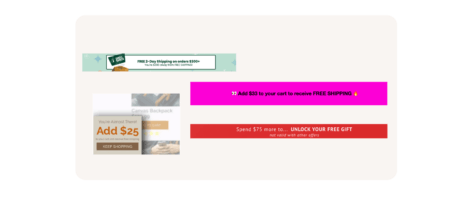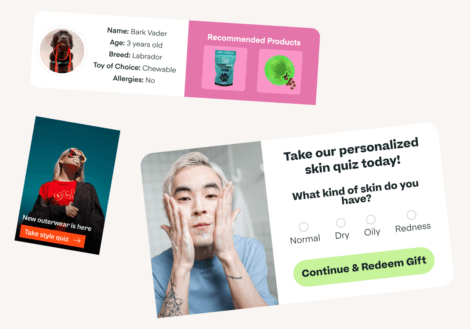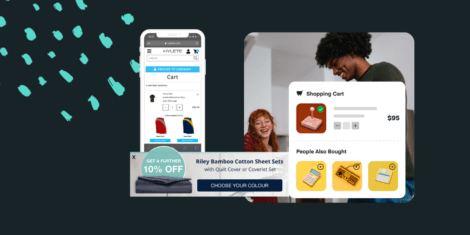In today’s fast-paced and highly digitalized world, personalization is the strategy that consistently provides excellent customer experience, drives business, and generates some of the highest returns. According to research, 88% of marketers have seen a positive ROI after employing effective personalization strategies in their campaigns.
Customer expectations have shifted significantly and now people expect a personal digital experience that has the same degree of personalization they get offline. The majority of them are used to personalized experiences from their social network, shopping recommendations, and news feeds, so much so that 71% of consumers find it annoying when content isn’t personalized.
This shift in expectations has caused businesses to change their tactics in order to be able to cater to this requirement specifically. According to research, 89% of companies are investing in personalization, and 88% of marketers claim that providing a positive customer experience is their main motivation.
In this post, we’re explaining the concept of onsite personalization and its importance, along with personalization strategies that will help you build a better virtual shopping experience.
Basics of Onsite Personalization
Onsite personalization (also often called website personalization) is the process of providing each of your website visitors with a customized experience. You can personalize their experience based on their past purchases, location, or behavior in a way that meets numerous business goals, including increased customer satisfaction, longer visit duration, increased site visits, a lower bounce rate, greater conversions, and a better reputation for the brand.
While the concept of personalization has been more prevalent in the retail sector, where a customer visits a store and the seller immediately displays products that meet their needs, the online marketplace has lacked the same level of personalization. However, more and more online companies are increasingly investigating onsite personalization and realizing its value, particularly in terms of customer experience and revenue generation.
Types of Onsite Personalization
Let’s take a quick look at a few onsite personalization tips and ideas for inspiration.
- Text. The written content visitors see on your website can be customized based on their interests and needs. For instance, your messaging might change based on where the website visitor is in the customer journey. A different headline might appear on your homepage depending on whether a visitor is returning or new to your site and arrived via a high-level blog post.
- CTAs. Did you know that personalized CTAs outperform generic ones by a staggering 202%? Luckily, personalizing CTAs is the simplest form of content to do. For instance, you can link to various products or downloadable content depending on the user’s preferences or where they are in the customer journey.
- Pop-ups. The right onsite personalization strategies are incomplete if you don’t offer personalized pop ups. Pop-up ads are a powerful marketing strategy. According to MailChimp, the average pop-up CTR across all industries is 2.6%, whereas the average conversion rate for all pop-ups is 3.09%. Justuno customers average closer to 5-7% conversion rates. Use consumer information to tailor pop-ups and direct them toward the appropriate website visitor demographics.
- Images. You can also display different images to different types of website visitors. For instance, an online fashion retailer can display different images to consumers of different genders or concentrate on lifestyle items that they believe will sell the most.
Why is website personalization important?
In a time when businesses are vying to stand out and grab users’ attention, employing personalization strategies can make a big difference. By showing your online visitors that you care about their interests and preferences while providing them with relevant content and experiences, you can encourage them to stay on your site longer and take the desired action. In turn, this will increase customer retention and improve brand awareness.
A good example of onsite personalization is Amazon. As you scroll on Amazon’s site, it keeps track of all the categories you visit, the kinds of products you are interested in, how long you spend looking at a given item, and much more. Using these details, the eCommerce giant further customizes your experience each time you visit its website, compelling you to think about buying a product despite your current purchasing needs. But you don’t need to be as big as Amazon and have their resources to apply the same principles of personalization and service to your own website.
Here are some of the most important benefits of personalization.
Better customer experience
Customers love a personalized experience. Most customers say they’re willing to give businesses access to personal information in exchange for a more personalized customer experience.
Connected customer experiences result in better customer relationships and, as a result, increased customer satisfaction. Onsite personalization enables you to communicate with your audience in a way that resonates with them and contributes to an increased number of conversions.
Relevant product recommendations
The biggest benefit of website personalization to your customer base are personalized product recommendations. Therefore, it comes as no surprise that 76% of consumers prefer to shop with businesses that offer them personalized product recommendations.
You can provide relevant and fast product recommendations based on your customers’ first and zero party data. Consider using retargeting ads that will provide you with specific customer engagement data you can use to automatically recommend the user’s instance of the homepage of your site with specific products. According to McKinsey, personalization often results in a 10% – 15% increase in revenue. The more effectively a business uses data to improve customer knowledge and connection, the larger the returns.
Lower bounce rates
Did you know that it only takes about 0.05 seconds for visitors to decide whether they like your website enough to stay or leave? Using onsite personalization also significantly reduces customer churn rates, which is a great advantage. One reason for this is that your website will be providing the right information at the right moment.
Effective personalization strategies should put the customer at their core. By putting your customers at the center, you’re making it easier for them to find and purchase the products they need at their own timing and pace. This, in turn, helps you turn visitors into customers faster and increase your sales further.
Higher conversion rates
High conversion rates across landing pages and CTAs are the key benefits of employing personalization strategies that work for you and your company. In fact, according to 90% of top marketers, personalization significantly boosts business profitability.
By offering your customers content, products, and offers that you know will appeal to them, you make it easier for clients to convert. You can use onsite personalization to increase your Average Order Value (AOV), create loyal customers, promote repeat business, and more.
Challenges of Onsite Personalization
Although there are many advantages to personalizing your website, it’s not always simple. Let’s examine a few typical problems that businesses face with onsite personalization:
Privacy issues. When gathering information about your existing and potential customers, you must be cautious about data protection. As we already mentioned above, most consumers are willing to provide their personal information in order to receive a personalized customer experience. It is your responsibility to ensure that you don’t betray that trust by using customer relationship management software that has strong security and compliance standards. Make sure to be aware of regulations like GDPR, CCPA, etc. based on where you’re operating and doing business.
Dependence on programmers. If you don’t have the right personalization tool, creating a customized website would require a lot of time and money. However, with a powerful tool like Justuno, you’ll be able to deploy hyper-personalization onsite without relying on a developer.
Data silos. Data is crucial for onsite personalization. Why? Because in order to provide the right message, you need to know who your website visitors are. This information is gathered from a variety of zero and first party sources, including site monitoring, customer relationship management software, and email analytics. In some cases, collecting the data isn’t an issue, but you might have trouble accessing and using that data. You won’t have a thorough understanding of who your consumers are and won’t be able to present them with perfectly customized website content if your website personalization solution is unable to integrate all of your data sources.
Photo by Anete Lūsiņa on Unsplash
How to Personalize your Website
We’ve talked about the challenges and benefits of personalization, but how exactly can you do it? In order to be effective, personalizing your website requires a number of tactics seamlessly working together. Here are 5 easy steps to develop effective website personalization strategies and enhance your digital customer experience:
- Use a personalization tool
As we mentioned before, using the right personalization tool is key to the most successful personalization strategies.
Justuno allows you to personalize all onsite customer touchpoints, from the first contact to the most recent conversion and beyond. Make every communication relevant to the visitors’ individual interests by using personalization to give them the impression that you understand who they are and what they want.
With the help of Justuno, you can employ customized onsite experiences to support off-site marketing campaigns, and keep site visitors moving through the sales funnel and interacting with your brand over time. it can also help you convert new consumers and strengthen relationships with your existing ones with onsite experiences that are tailored based on their preferences, interests, clicks, views, prior orders, traffic sources, shopping cart contents, etc.
- Gather website visitor data
It’s worth mentioning again that data is the foundation of your onsite personalization efforts. The more information you have about your website visitors, the more successfully you can target their interests and needs.
The good news is that you already know quite a lot about your visitors. Email analytics, website analytics, ad interactions, customer satisfaction surveys, mobile app data, in-store and online purchases, customer support requests, etc. are a few typical sources of first-party user data you can rely on.
- Divide your audience into segments
This stage involves taking all of your data and segmenting your audience into smaller groups of people that share common traits.
For instance, you might have information about website visitors who have looked at particular pages, as well as data from a survey you have previously sent out. Both these sources identify users that have a special interest in a certain product, you can categorize them together in a segment. You can then use these customer segments to target onsite experiences for maximum relevance. Depending on the group you assign audience members to, they will view different content. Justuno allows you to do this using the Audiences section where profiles, properties, and segments are all used to collect, organize, and use data so that every visitor can see the right message at the right time.
- Plan out your personalization campaigns
Once you have segmented your audience, it’s time to choose the personalized content you will show to each subgroup. The first step is to decide what you want to achieve. Then, decide how personalized content might assist you in achieving your goals.
For instance, a campaign to lower your blog’s churn rates will look different than one to increase cross-sells and upsells. In the cross-selling scenario, customers who have previously purchased a certain item could see personalized product recommendations, whereas if your goal is to lower your bounce rate, you might start displaying blog entries based on the kinds of links visitors clicked in earlier emails.
- Measure your success
Finally, be sure to measure the success of the onsite personalization strategies you’ve employed. Not every personalized customer experience will be successful, which is why it is crucial to constantly monitor how these experiences are doing and make adjustments as necessary. Here are a few metrics that will help you determine if your personalization efforts are successful.
- Frequency of site visits. This metric shows the total number of times each user has visited your website. It enables you to evaluate the percentage of new users on the website as well as their level of familiarity for your returning visitors.
- Time on site, also known as session duration, is the total amount of time that a visitor spends on your website.
- Number of website pages visited. Do your visitors go to other pages on your website after reading your blog article or company information? If they do, it’s a strong indication that your personalized content suggestions and calls to action are effective.
- Number of actions taken on site. You can also monitor how frequently visitors take an action on your website, like completing a form or downloading an asset.
- Conversion rates. Understandably, conversions are the ultimate objective of all onsite personalization strategies so be sure to determine how many visitors into customers you have turned thanks to your personalized content.
Justuno allows you to create custom analytics dashboards so you can measure the success of your personalization campaigns based on the metrics most important to your business. It’s never been easier to make data-driven decisions for your onsite campaigns!
The Bottom Line
Being relevant, responsive, personal, being able to convince people that you have the right products for them, and turning visitors into customers is the key to setting your business apart in today’s fiercely competitive online market landscape.
Onsite personalization isn’t just another trend you can experiment with but a strategy that enables you to interact with your consumers quickly and effectively, improve your cross-channel marketing, and boost ROI. The good news is that a high level of personalization doesn’t necessarily need spending hours manually segmenting your audience and creating offers from scratch. It can be done with ease by using Justuno’s product suggestions or one of the platform’s advanced targeting rules.





